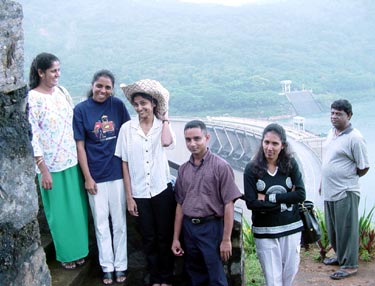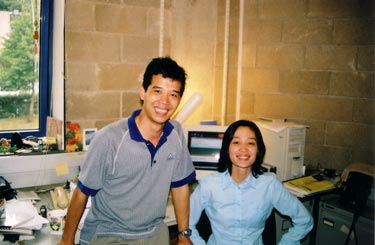Tiempo Climate Cyberlibrary
Empowering the Vulnerable
- Tiempo archive
- Complete issues
- Selected articles
- Cartoons
- Climate treaty
- Latest news
- Secretariat
- National reports
- IPCC
About the Cyberlibrary
The Tiempo Climate Cyberlibrary was developed by Mick Kelly and Sarah Granich on behalf of the Stockholm Environment Institute and the International Institute for Environment and Development, with sponsorship from the Swedish International Development Cooperation Agency.
While every effort is made to ensure that information on this site, and on other sites that are referenced here, is accurate, no liability for loss or damage resulting from use of this information can be accepted.
 |
Lareef Zubair suggests that if vulnerable communities are empowered to cope with present-day climate change then the lessons learned can be utilized for longer-term adaptation. |
|
The author is an Associate Research Scientist at the International Research Institute for Climate Prediction in New York, United States, and a Principal Scientist in the Natural Resources Management Services, Polgolla, Sri Lanka. He is also the founder and coordinator of the Sri Lanka Meteorology, Oceanography and Hydrology Network. |
|
There is an immediate and compelling need for climate change information, particularly on the time scale of months to upcoming years. Officials and decision makers in national ministries, for example, plan months and years ahead rather than for decades and centuries. It is the next few years that are of concern to these people.
The demand for present-day climate change information from vulnerable communities is increasing. In Sri Lanka, for example, at a training programme on climate change in 2002, the Secretary of the Sri Lanka Ministry of Plantations urged scientists to develop climate information. He stressed that this information was needed immediately in order to aid drought-related agricultural plantation management for the upcoming seasons and years.
In December 2003, at a workshop on using climate information for early warning systems for malaria epidemics in Sri Lanka, regional malaria officers insisted that it was a matter of a priority to take care of the season-to-season and year-to-year variation.
With a prolonged period of a nine-month rainfall deficit through late 2003 to April 2004, river basin managers in the central region of Sri Lanka sought immediate information as to how they should manage water resources.
At the same time, there is an increasing recognition of the risks associated with long-term climate change in the tropics. In many low-lying areas and in most small island developing states, climate change is regarded as a security issue. In other vulnerable regions, such as the Sahel region in Western Africa, the consequences of longer-term climate change are disastrous. Yet, in general, throughout many of these vulnerable regions of the tropics there is only a hazy understanding of the local risks and consequences of the climate threat.
At the level of international negotiations, policy making, editorializing, funding and consciousness, the concerns about climate change have more visibility than the shorter-term issue of climate variability. Yet the order of magnitude of season to annual climate variability is several times larger than climate change signals in most places. Even to deal with the latter, one needs a handle on the former.
Information on both short-term climate variability and long-term climate change is needed at the local and regional level. The need is particularly urgent in fields such as disaster-management, water resources, fisheries, energy, agriculture and health.
Lessons from a series of projects in Sri Lanka aimed at developing comprehensive climate services focused on climate variability are presented in this article. The work was conducted in collaboration with many Sri Lankan scientists.
Enhancing climate science and technology capability
Climate science and technology capability should be developed in situ in the vulnerable regions. It is only when this occurs that science and technology is likely to be fully contextualized to the specific locality. Adequate knowledge is then likely to be disseminated in the appropriate languages, idiom and formats to decision makers, policy forums, professionals and scientists. Such knowledge emanating from local sources is more likely to be understood, trusted and integrated into action plans and educational programmes.
To develop capability in climate, one should start with a good understanding of local climatological information, add on information on climate variability, and then establish projections for climate change. Some key steps in developing such capability include the following.
- Climatological information on rainfall, temperature, streamflow, soil moisture and vegetation along with the likely historical variations of these parameters is useful and can provide guidance in the first instance. Essential data sets on climatology and historical variations must be widely available.
- Rainfall, temperature, streamflow, soil moisture and vegetation patterns can be monitored and this information used alongside climatological knowledge to predict various parameters. For example, rainfall patterns in the upstream of longer rivers are very useful in estimating floods in the downstream. Similarly, snow melt and soil moisture information can be useful for water shed management. Yet often the information systems needed to obtain, assimilate and disseminate the information in appropriate formats to potential users is not available.
- Climate variability in the coming season and year may be anticipated by understanding the dynamics of the regional climate. The relationships of the regional climate to land and ocean conditions may be used to anticipate climate variability.
- There could be a greater use of remotely sensed information which is available over the Internet. Often, the information may be too coarse for relevant application but for some purposes, one can glean useful information. Global seasonal climate predictions can be evaluated locally for skill, coverage and applicability.
Empowering local scientists and technologists should include support for improving local science and technology institutions, networks and research and funding opportunities.
Improving vulnerability studies, impact analysis and adaptation assessments
Understanding the sensitivity and vulnerability of the environment and society to climate change is as critical as understanding climate. Expertise that links local understanding of disasters, health systems, water resources, agriculture, energy and fisheries is essential if climate information is to be translated into meaningful parameters for decision makers, policy makers and the general public.
Climate, its impacts and adaptation to it, is a multidisciplinary and wide-ranging umbrella that needs a variety of resources available in a variety of disciplines. Often, engendering multi-disciplinary work is difficult unless there is an immediate practical problem and a specific target that a group can work towards. Project-oriented studies provide such a target. They ensure that the synthesis from a multi-disciplinary group meets the test of relevance.
Immediate projects to address the implications of climate variability and climate change in an actual setting and which develop adaptation approaches are a concrete practical approach to developing capacity. A project-based, problem-solving approach provides a concrete focus for collaboration between participants who may have relevant but diverse expertise. Attempting to bring together such expertise on practical issues is much more likely to yield more meaningful collaboration and insight than collaboration on conceptual issues.
Data on projects where climate information is used to develop mitigation and adaptation strategies would provide a particularly important component of an information base for management, coping and adaptation strategies.
|
|
Young scientists from the Sri Lankan Climate Assessment, Prediction and Adaptation Group at the Victoria reservoir, the major source of hydroelectricity in Sri Lanka © Lareef Zubair |
Harnessing the lessons from coping with climate variability
Understanding and coping with short-term climate variability provides a testable means of developing adaptation for long-term climate change. Similarly, impact studies for shorter-term variability provide a test-bed for assessing impacts to longer-term changes.
If the suite of tools, training modules and data sets to deal with climate variability are developed they can be applied to climate change issues. For example, the methodology that is in use for downscaling from global climate model outputs to a fine grid is similar whether it is for a shorter or a longer term. There is a similarity in linking analysis of agricultural systems to climate. Thus, the work of interpreting impacts of climate variability remains relevant, although not exclusive, to the longer-term issues of climate change.
Of course, preparing to cope with climate variability alone is enough to adapt to climate change. Climate change is a threat to human and ecological survival in a way that climate variability alone is not. There are some methodological differences in adaptation to longer-term climate change that need to be addressed starting immediately.
An enabling infrastructure for climate science
Although there is often funding from external sources for concrete projects, the infrastructure needed to sustain science is left to national sources that are under-funded. Some scientists within national organizations are awarded external grants. These are often focused on concrete deliverables that do not include broad involvement.
In many instances, there is a section in project proposals about the communication of results to stakeholders, but the necessary handing out of flyers or invitations at project meetings is insufficient where the scientific infrastructure in general is poorly funded. Continued external funding of scientists without appropriate safeguards naturally leads scientists to be externally oriented rather than engaged locally.
While projects should be awarded on a basis of merit of the proposal and the capability of team members, it should also be important to ensure that such projects meld into institutional plans. All the funding for projects by itself would not ensure the development of scientific capability unless resources are provided for the basic scientific infrastructure as well.
In too many of the vulnerable nations, facilities for those working on this issue are inadequate. In order to achieve some success in their work, scientists and researchers need library facilities, inter-library loan facilities, proper cataloguing systems, internal communication, regional or national journals, facilitation of regional meetings and small grant facilities. Computer facilities and internet access are also crucial in providing necessary tools for scientists and researchers. Although, in recent years, access to these has been tremendously improved, more needs to be done, specially for those working in the provinces.
|
|
Young scientists from Vietnam © Mick Kelly/Tiempo |
Empowering younger scientists
Younger scientists are our people who can provide the dynamism and continuity needed in ensuring that our communities will be able to adapt to climate change over coming decades. But in many tropical countries, there are few opportunities for new graduates to undertake research due to diminishing funding and support for the science and technological infrastructure. This has resulted in a sadly increasing sense of disillusionment.
Providing younger scientists with opportunities would ensure that there is a greater representation of female scientists, as there appears to be a better gender parity among more recent graduates.
It is often the case in the tropics that only senior scientists have their name recognized and subsequently gain access to metropolitan centers of funding. When any funding and evaluation of capacity building programmes in the South is provided remotely from metropolitan centers in the North, there is often undue focus and repeated opportunities given to older established scientists.
Some established scientists are conscientious and will mentor younger colleagues and will assist in providing them with the necessary exposure. Sadly, this is not always the case. There are some scientists who exhibit little responsibility in their work on climate change assessments and projections and this irresponsibility will usually only be proven after they retire.
The older established scientists are usually located in capital cities that already have better facilities than those in the peripheral regions even within the country. Just as there needs to be a vastly improved regional capacity to undertake science and research, there also needs to be an empowerment of scientists in peripheral regions within countries. The reaching out to younger scientists may help in this regard but it may not be entirely adequate.
Summing up
Vulnerable communities need to be empowered to cope with climate variability and climate change. As part of this process, there must be practical steps taken to support, strengthen and empower local scientific, technological, societal and institutional capabilities.
It is important to contextualize climate information in terms of other biophysical, socio-economic and cultural information for the area of its application. In developing application methodologies, one may gain much by focusing on immediate practical problems in a pilot or demonstration project mode and learning from their implementation.
Coping with climate variability provides lessons, tools and a robust training ground for adaptation to longer-term adaptation to climate change. External funders should focus on providing direct support to younger scientists. This would go far in helping support equity and the long-term robustness of any regional, national and local scientific capability.
Further information
Lareef Zubair, International Research Institute for Climate
Prediction, Lamont Doherty Earth Observatory of the
Columbia University, PO Box 1000, Palisades, NY 10964-8000,
USA. Email: lareef@iri.columbia.edu.
Web: iri.columbia.edu/~mahaweli/.
On the Web
Further information on the issues covered in the present
article can be found on the Sri Lanka Meteorology, Oceanography
and Hydrology Network site. Lareef Zubair discusses
saving weather data for Sri Lanka in a recent Tiempo
article.
Bright Ideas

General Electric plans to cut solar installation costs by half

Project 90 by 2030 supports South African school children and managers reduce their carbon footprint through its Club programme

Bath & North East Somerset Council in the United Kingdom has installed smart LED carriageway lighting that automatically adjusts to light and traffic levels

The United States National Oceanic and Atmospheric Administration and the American Public Gardens Association are mounting an educational exhibit at Longwood Gardens showing the link between temperature and planting zones

The energy-efficient Crowne Plaza Copenhagen Towers hotel is powered by renewable and sustainable sources, including integrated solar photovoltaics and guest-powered bicycles
El Hierro, one of the Canary Islands, plans to generate 80 per cent of its energy from renewable sources

The green roof on the Remarkables Primary School in New Zealand reduces stormwater runoff, provides insulation and doubles as an outdoor classroom

The Weather Info for All project aims to roll out up to five thousand automatic weather observation stations throughout Africa

SolSource turns its own waste heat into electricity or stores it in thermal fabrics, harnessing the sun's energy for cooking and electricity for low-income families

The Wave House uses vegetation for its architectural and environmental qualities, and especially in terms of thermal insulation

The Mbale compost-processing plant in Uganda produces cheaper fertilizer and reduces greenhouse gas emissions

At Casa Grande, Frito-Lay has reduced energy consumption by nearly a fifth since 2006 by, amongst other things, installing a heat recovery system to preheat cooking oil
Updated: May 15th 2015

